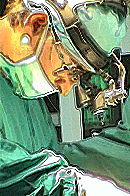 Initial evaluation of a
patient with symptoms and signs suggestive of an
intracranial mass lesion should consist of either a CT or
MRI examination. If CT is the initial imaging study and an
intracranial mass suspicious for glioma is shown, or if a
normal or nonspecific CT examination is obtained in the
setting of strong clinical suspicion for a mass, an MRI
scan is usually obtained for complete evaluation.
Initial evaluation of a
patient with symptoms and signs suggestive of an
intracranial mass lesion should consist of either a CT or
MRI examination. If CT is the initial imaging study and an
intracranial mass suspicious for glioma is shown, or if a
normal or nonspecific CT examination is obtained in the
setting of strong clinical suspicion for a mass, an MRI
scan is usually obtained for complete evaluation.
Although MRI is well
recognized to be a more sensitive imaging technique, CT is an
acceptable alternative for the initial evaluation of many
patients for several reasons. CT is less costly, is a more rapid
imaging modality, and is generally more available compared with
MRI. CT is also useful in patients who, because of severe claustrophobia, would
need heavy sedation for an MRI examination. Patients with
contraindications to MRI, such as a cardiac pacemaker or
intracranial aneurysm clips, can also be studied with CT.
CT is often essential as a
complementary study for patients with MRI-demonstrated
intracranial lesions. CT provides detailed evaluation of bony
anatomy and morphology for proper positioning of a craniotomy
bone flap, for determining the number and placement of
radiotherapy ports, and for evaluating patients with lesions
adjacent to or invading the skull base or calvarium.
CT can also detect the
presence of calcification associated with a mass lesion, which
can help narrow the differential diagnostic possibilities. For
example, peripheral calcification along the rim of a mass may
indicate the correct diagnosis in cases of giant aneurysm that
may mimic an intracranial neoplasm.
CT combined with the
intravenous administration of an iodinated contrast agent
provides additional information. The presence or absence of
enhancement together with the pattern of enhancement helps to
characterize a mass lesion. Small focal cerebral lesions such
as metastases, and subependymal or leptomeningeal tumor
extension may only be visualized following contrast injection.
In cases of multiple lesions or lesions that incompletely or inhomogeneously enhance, the best site for biopsy is indicated
by the brightest area of enhancement, which generally is the
zone of the most actively growing tumor cells. Finally,
postoperative tumor recurrence and radiation necrosis are both
best detected on postcontrast imaging studies.

